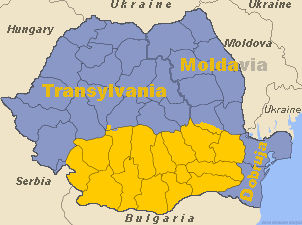| Revision as of 21:24, 13 December 2004 editJonathunder (talk | contribs)Autopatrolled33,396 edits →Important rulers: English version of name← Previous edit | Revision as of 05:03, 15 December 2004 edit undoJonathunder (talk | contribs)Autopatrolled33,396 editsm →History: use name most common in EnglishNext edit → | ||
| Line 24: | Line 24: | ||
| The tribute paid to the Turks allowed Wallachia (and Moldavia too) to maintain its autonomy. | The tribute paid to the Turks allowed Wallachia (and Moldavia too) to maintain its autonomy. | ||
| In ], Wallachia voted to unite with Moldavia to form the state of ], under the rule of ]. | In ], Wallachia voted to unite with Moldavia to form the state of ], under the rule of ]. | ||
| == Important rulers == | == Important rulers == | ||
Revision as of 05:03, 15 December 2004

Wallachia (also spelt Walachia; Romanian: Ţara Românească - literally "Romanian country"; Turkish: Iflak) formed a Romanian principality in eastern Europe from the late Middle Ages until the mid-19th century.
The capital city changed over time, from Curtea de Argeş to Târgovişte and finally Bucharest.
Geography
Wallachia was situated north of the Danube and south of the Carpathian Mountains.
Its neighbours were the Ottoman Empire to the south, Transylvania to the north-west and Moldavia to the north-east.
History
Beginning with the tenth century, Byzantine, Slavic and Hungarian sources, and later Western ones mention the existence of small states peopled by Romanians under leaders known as cneji or voievozi - at first in Transylvania, then in the 12th-13th centuries in the territories east and south of the Carpathian Mountains. A specific characteristic of Romanian history from the Middle Ages to modern times is that they lived in three adjacent principalities - Wallachia, Moldavia and Transylvania, which was an autonomous voivodship of Hungary.
In the 14th century, along with the decline of the neighboring Poles, Hungarians, Tatars, several feudal states formed in the south and the east of the Carpathian Mountains - Wallachia under Basarab I (around 1330) and Moldavia under Bogdan I (around 1359).
In the second half of the 14th century, a new threat appeared - the Ottoman Empire. After having first gained a foothold in Europe in 1354, the Ottoman Turks reached the south bank of the Danube in 1396.
Alone or allied with the neighbouring Christian countries, rather than in alliance with the other two Romanian principalities, Mircea the Elder (1386-1418) and Vlad Tepes (1456-1462) of Wallachia, Stephen the Great (1457-1504) of Moldavia and Janos Hunyadi, prince of Transylvania (heroic figure to both Romanians and Hungarians), fought many defensive battles against the Ottomans, preventing them from expanding into Central Europe.
As the whole Balkan Peninsula became Turkish territory and following the fall of Constantinople to Mehmed II in 1453, the Romanian principalities had to accept the suzerainty of the Ottoman Empire for more than three centuries, though there were a few attempts to regain independence: (Michael the Brave in 1600 managed to unite for a short period of time all the three principalities).
The tribute paid to the Turks allowed Wallachia (and Moldavia too) to maintain its autonomy.
In 1859, Wallachia voted to unite with Moldavia to form the state of Romania, under the rule of Alexander John Cuza.
Important rulers
- Litovoi, on the east side of the Olt river, 1247-1277,
- Seneslau, on west side of the Olt river, at Arges, c.a.1247
- Barbat, c.a.1277-c.a.1290
- Tihomir, c.a.1290-c.a.1310
- Basarab I, about 1310 - 1352
- Vladislav I or Vlaicu-Voda, 1364-c.a.1377
- Mircea cel Batrin (Mircea the Elder), 1386-1418
- Vlad Tepes (Vlad the Impaler), 1448, 1456-1462, 1476
- Neagoe Basarab, 1512-1521
- Mihai Viteazul (Michael the Brave), 1593 - 1601
- Alexander John Cuza, 1859 - 1866
See also the complete List of Wallachian rulers.
Idiomatic use
In modern German, Wallachei is used much as the English expression middle of nowhere.
External links
| Banat |
|
|---|---|
| Dobruja |
|
| Moldavia |
|
| Transylvania | |
| Wallachia | |
| |